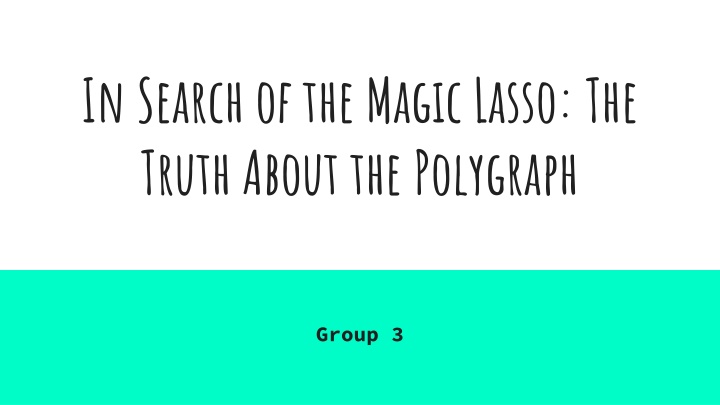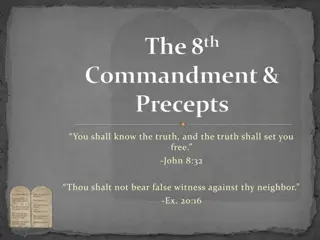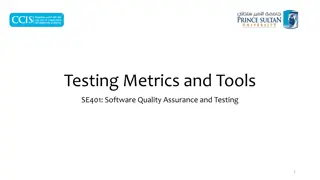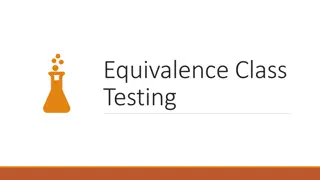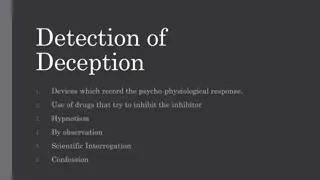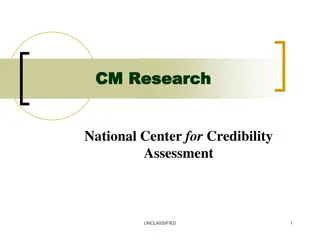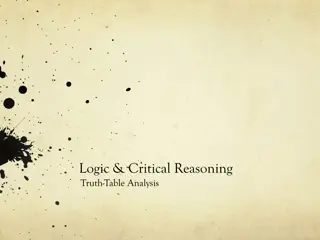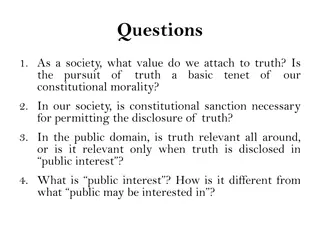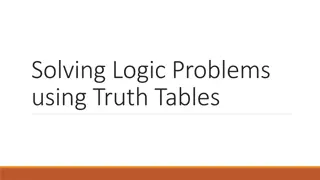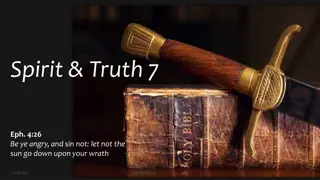Unveiling the Truth Behind Polygraph Testing: A Comprehensive Overview
Delve into the history and controversies surrounding polygraph testing, from its introduction in the 1920s to modern-day debates on its effectiveness. Explore pivotal cases like Frye v. United States, the evolution of testing standards, and the reluctance of government agencies to embrace this tool. Discover the findings of the National Research Council study and the ongoing discourse on the reliability of polygraphs for security screening.
Download Presentation

Please find below an Image/Link to download the presentation.
The content on the website is provided AS IS for your information and personal use only. It may not be sold, licensed, or shared on other websites without obtaining consent from the author.If you encounter any issues during the download, it is possible that the publisher has removed the file from their server.
You are allowed to download the files provided on this website for personal or commercial use, subject to the condition that they are used lawfully. All files are the property of their respective owners.
The content on the website is provided AS IS for your information and personal use only. It may not be sold, licensed, or shared on other websites without obtaining consent from the author.
E N D
Presentation Transcript
In Search of the Magic Lasso: The Truth About the Polygraph Group 3
Outline Timeline of Events Polygraph - an effective tool for screening purposes? Data from the NRC Study Why is the government agency unwilling to use polygraph? Conclusion Take-Home Message
Questions to address Do you think polygraphs are an effective tool for security screening purpose? Why do you think government agencies were unwilling to adopt the recommendations of the committee?
Introduction to Polygraphs aka lie detectors Measures blood pressure, pulse when subject is asked and answers questions Belief that deceptive responses produce physiological responses different from that of non- deceptive responses
Timeline of Events -1923 Case of Frye v. United States Introduced use of systolic blood pressure to measure deception in lab or legal settings by William Moulton Marston Frye initially denied to the crime -> confessed but then retracted his confession -> judge refused to accept his systolic blood pressure measurement to prove his innocence -> eventually convicted -> turned out Frye was innocent Frye general acceptance test
Timeline of events -1993 Daubert test superseded Frye general acceptance test Trial court judges to decide whether the scientific, technical or other specialised knowledge is reliable and valid More and more courts infused general accepted test with Daubert test
Timeline of events -2000 onwards 1998: Wen Lo Hee - accused of theft of classified nuclear-related documents Debate over whether he failed polygraphs tests administered to him National Research Council(NRC) conducted a study of polygraph testing s ability to accurately distinguish lying and truth-telling in various situations Assembly of Committee to Review the Scientific Evidence on the Polygraph
Timeline of events -2000 onwards (cont) 2001 Sept 11 changed US public s perception towards to polygraph testing Placed greater faith that modern tech can precisely detect evildoers Problem: lack scientific basis
Is polygraph an effective tool for security screening purpose The validity of polygraph depends on the purpose for which it is used. However, when the questions asked are too generic, there may be some ambiguity and this may result in the test being inaccurate. Validity is further compromised when prospective(future) questions are asked as they are making inference about future behaviors.
Is polygraph an effective tool for security screening purpose Limitation to research methods Laboratory studies lack realism (the consequence associated with lying never mirrored the seriousness of these actions in real-world settings)--> overestimate accuracy) Field studies difficulty of identifying the truth against which test results should be judged and lack control of extraneous factors. Estimates of accuracy from these studies are almost certainly higher than actual accuracy of specific-testing in field.
Representation of data from the nrc study -#1 Use of scatterplot Advantage: - Summarise all the relevant data from the study - Visible variability in results - Better than presenting numbers -> easily misunderstood as percentage of correct results - > misimpression that polygraph perform better than chance
Representation of data from the nrc study -#2 Calculations of the results of hypothetical series of polygraph examinations in hypothetical large populations with known populations of liars and truth-tellers
Timeline of events -2000 onwards (cont) NRC s conclusion: - Avoid overconfidence in polygraph screening results NRC s recommendation: - to minimise reliance on polygraph tests and seek ways to improve public safety and national security - Government agencies responsible for national security were not pleased
Why is the government agency unwilling to not use polygraph? Absence of an alternative solution to polygraph testing, thus no desire to change its polygraph policy
Why is the government agency unwilling to use polygraph? Polygraph test that are sensitive enough to spot most security violators will also mistakenly marks many innocent test-takers as guilty. While those that are not sensitive enough will not be able to catch the major security violators. The government agency believes that the use of polygraph will do more harm than good. They feel that national security is too important to be left for a such blunt instrument.
Conclusion The polygraph can be use to assist law enforcers and intelligence agencies to help detect criminals, spies or saboteurs when direct evidence is lacking. However, it cannot be use as a conclusive evident as in some cases there may be some ambiguity which may result in the test being inaccurate.
Take-home message Myths are not meant to be believed, but for entertainment purposes.
